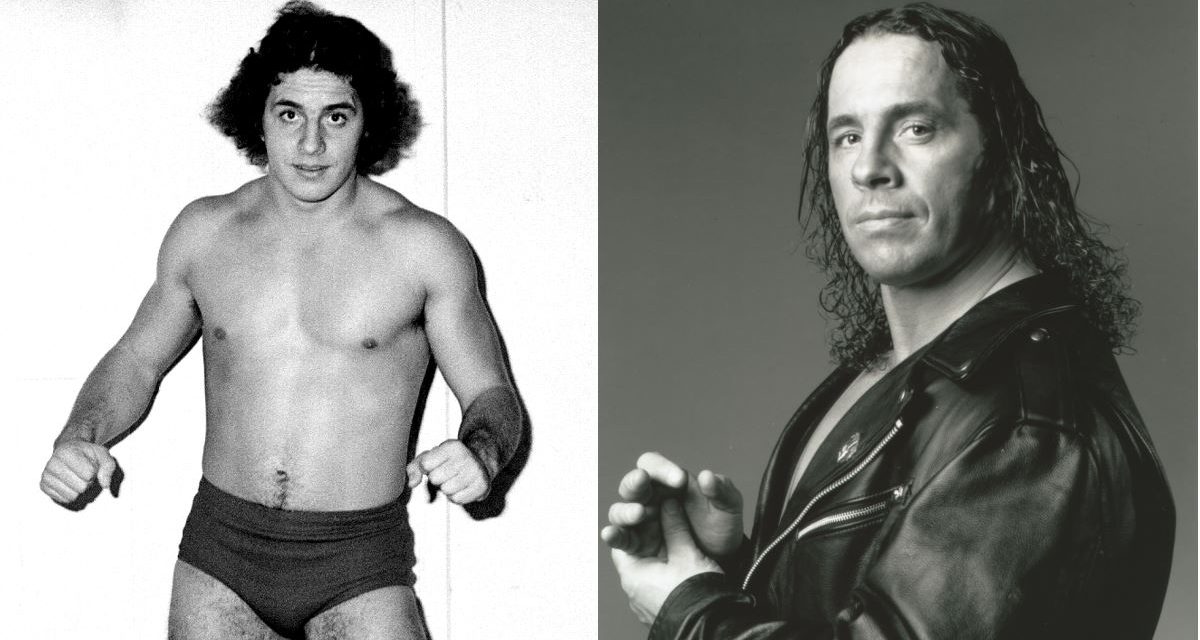November 9th marks the 20th anniversary of a match that would change wrestling forever. Bret Hart defending his WWF title against Shawn Michaels was only supposed to be one of Hart’s last matches in the company, and the main-event of Survivor Series 1997. Instead, it became known as the Montreal Screw Job.
At Survivor Series 1997, in the middle of the ring in Montreal’s Molson Centre, Shawn Michaels won the WWF World championship. Earl Hebner called for the bell, signalling a submission following a sharpshooter. It was Bret Hart’s finishing move, but it was being applied by Michaels.
In itself? Nothing special.
But the events which followed — including Bret Hart spitting in Vince McMahon’s face in front of the cameras and the crowd — made it one of the most memorable occurrences in the history of wrestling.
“One of the most famous and almost surely the most talked about match ever in North American wrestling history,” is what Wrestling Observer Newsletter‘s Dave Meltzer called it.
On November 9, 1997, a total of 20,593 people witnessed a change in the direction governing the WWF and a turning point in the history of the professional wrestling business. If the most knowledgeable fan understood some of what had just happened, everyone else was asking serious questions. Since then the Montreal Screw Job, as it has become commonly known, has been a matter for debate and speculation.
“All I know is that we worked a really hard match. A sort of hasty truce was made earlier that day. Shawn implied that he didn’t want trouble and wanted to be left out of it. He was very cooperative,” remembered Bret Hart in Survival of the Hitman, a documentary presented on the Fight Network in 2010.
Then suddenly everything collapsed.
“I could hear someone say: ‘Ring the bell!’ That’s when I knew it was Vince McMahon. I finally realized that they screwed me,” Bret Hart recalled bitterly in the documentary Wrestling with Shadows.
Bret wasn’t alone. The Molson Centre crowd was in shock: it was that obvious the bell was rung without Bret giving up.
“Earl Hebner was a very good friend of mine. I don’t blame him for what he did. I felt bad that they put him in this predicament. They caught him like a gangster just before he went through the curtain; his job was at stake, even if he promised to protect me on the eve of the match,” Bret said, philosophically.
“Had I been in his place, would I have done the same thing? Probably,” affirmed Jimmy Korderas, a former official for the WWE, supporting his colleague’s decision. “You don’t have the time to think, and it’s either this or you lose your job. A big contract waited for Bret, not the referee.”
“When Bret started to destroy the equipment and began drawing the letters WCW in the air, there was no doubt that we had just seen something extraordinary. A piece of history,” remembere François Poirier, a.k.a. Frank Blues, the founder of the Montreal NCW promotion.
In the locker room the situation was not much better.
“I was backstage with The Undertaker. It was like a movie. Suddenly everyone went from shock to anger. I have never seen it like that backstage to this day. I thought it was going to be a real close call … where there would be a riot. There were a lot of angry people,” Carl DeMarco, former president of the WWE in Canada, said.
“It should have been a DQ, the Hart Foundation was to come in, then Hunter [Hearst-Helmsley] and then the referees were to pull them apart,” related Korderas. “I was backstage and was waiting for my cue, which never came. I was wondering what was going on and when I finally saw what had happened, I told myself: ‘Oh, sh–!'”
Back in the locker room Hart was both furious and disappointed. He was wondering who was in the know, and Shawn Michaels was on top of that list.
“God as my f—ing witness, my hands are clean on this one. I swear to God,” that’s what we hear Shawn Michaels say in Wrestling with Shadows.
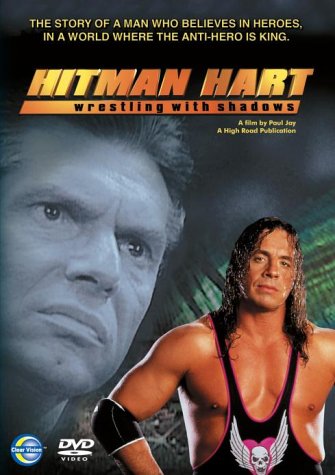
The documentary Wrestling with Shadows
Six years later, Michaels revealed the truth on a WWE Spike TV show: “Yes, I knew. I was asked to do something by the man who has given me the opportunity to have everything that I have in my life. A man who has stuck by me that I stuck with. He asked me to do it, and I did it. I’m not sorry for it.”
But on the DVD Greatest Rivalries: Shawn Michaels vs. Bret Hart, Michaels had a different take: “I had a ton of guilt, but I honestly felt I was a soldier doing what I was told to do. It was by no means a moment in my life and career that I relished. I will tell people there was not one desirable thing about doing that.”
THE DARK MAIN-EVENT: BRET vs. VINCE
Afterward Vince McMahon had no other choice but to apologize to Bret, to keep colleagues like The Undertaker happy. His excuse was that he couldn’t take the chance that Bret might walk onto WCW still WWF champion, something that was told over and over after the event. The truth is, this could’ve never happened. Bret’s contract was still good until November 30th. So he could not have gone to Nitro before December 1st. The worst Eric Bischoff could have done is to announce that he had signed the WWF champion, the very next night, but Hart had asked him not to, and Easy E agreed.
Heated words ensued, and Hart asked McMahon to leave. McMahon did not oblige. What happened next occurred in the dressing room of the legendary Montreal Canadiens.
“Somehow Vince ran into my hand. I drilled him as hard as I could. It was the right thing to do. There was no other choice but to get up and punch Vince one time and then let it go. That’s a Stu Hart judgment call,” recounted Hart in Wrestling with Shadows.
“I was in the locker room with Bret when Vince came in. Vince told Bret that he did what he had to do for the business and if Bret wanted to take a shot at him, he could,” revealed Sgt. Slaughter. “Bret acted like he was going to leave, but turned around and threw a punch at Vince. Then he looked at Shane McMahon and told him he was next and then looked at Gerald Brisco and told him he was next, so I decided to interfere. Bret told me he had nothing against me so I told him that if that was the case, to stop now and leave the room.”
Many wrestling scenarios conceived since have tried to showcase themselves as representing moments that would change wrestling for good, but the truth of the matter is, nothing will ever match that night.
“The biggest name in wrestling and the biggest promoter in wrestling on national television saying: ‘It’s fake!’ I can no longer kayfabe. To me that’s why it’s such a watershed moment. The kayfabe era died that day,” said former wrestler Lance Storm.
From that moment on the WWF seemed freed and finally able to change its destiny. Until Montreal the company was losing the battle against WCW. In the six months before Survivor Series 1997 the WWF managed to crack a 3.0 rating for Raw just three times. After November 10, 1997, and up until the last WCW broadcast on March 26, 2001, Monday Night Raw scored less than a 3.0 just once. In the six months that followed the screw job, the WWF put an end to more than 80 weeks of consecutive dominance of WCW’s Nitro.
“I don’t want to say that the Screw Job saved the WWF, but it was one of the things that allowed for the re-emergence of the company, mainly because Vince McMahon became an excellent heel,” added Korderas.
The WWF found itself with an owner it could cast as the evil boss, the type of tyrant everybody had to deal with in the course of their lives.
“That whole incident was the start of making Vince McMahon the biggest heel in the business history. He didn’t want to be, by the way, but everyone around him told him he just should run with it,” DeMarco explained.
“Without Montreal Vince McMahon probably wouldn’t have become a character,” confirmed Meltzer.
HOW IT ALL STARTED
To better understand why that happened, we have to go back to October 1996. Hart’s contract was up and WCW showed a lot of interest, willing to give him a three-year contract that would allow him to do movies, something reported to be in excess of $9 million dollars. McMahon then offered a deal he would later regret: a 20-year contract, worth $1.5 million for the first three years, then Bret would be moved to a decision-maker office position for the remainder of his contract, so a $10-million deal. The offer would also allow him to get creative control over his last month worth of booking if he chose one day to leave. So Hart chose to stay with his employer of the last 12 years.
“Everything I have ever done and plan on ever doing, I owe it all to my WWF fans and I will be with the WWF forever!” Bret said at the announcement of his decision on Raw in 1996.
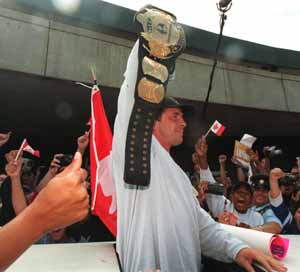
Bret Hart gets a hero’s welcome at the Calgary airport earlier in 1997.
But the company’s critical financial situation compelled Vince McMahon to free Bret from his contract and to let him negotiate with WCW.
“Vince was looking for a loan and was asked to cut short-term costs, so Bret’s weekly salary being by far the highest,” said Meltzer. “He asked Bret to take less money but he’d make it up to him later and Bret refused. So that was the impetus, but by October, the financial situation had turned around because when they raised prices for pay-per-views, that brought in a lot more money and the decline in buys from raising the prices didn’t happen.”
It was too little too late for McMahon as Hart finally chose WCW’s offer. The contentious point in this whole situation was that Bret Hart was the WWF World champion when this was happening. In fact the problem was made worse because of who the WWF wanted to put over and where the match was to take place. The WWF had settled on Shawn Michaels.
“Bret didn’t want to lose to Shawn Michaels. The two even had battles in the locker room,” explained Raymond Rougeau.
The two men didn’t trust each anymore to the point it was hard for them to work together for the well-being of the company. Also, from the get-go Hart refused to lose in Canada. But if there was one place in Canada where Hart could have lost, it was Montreal. Because of the language barrier, he was never as popular in the province than elsewhere in Canada. He was never a box-office draw like the Rougeaus or the Vachons were.
On the day of the match the news of Bret’s imminent departure was everywhere, even in the headlines of the most important Canadian newspapers. His departure was no longer a secret. The disagreement between Hart and Michaels was no longer a secret, either. But in a shocking twist it helped the WWF. Because of this, Survivor Series 1997 beat WrestleMania in buys — 250,000 against 237,000 — becoming the only PPV ever to do so.
“Rather than hurt business, it led to incredible — by the standards of a weak WWF at that time — late interest in the match,” said Meltzer.
WHO KNEW AHEAD OF TIME?
In order to convince both men to get in the ring, Vince McMahon agreed to a scenario in which it would’ve led to a disqualification and a battle between DX and the Hart Foundation.
“A lot of people were very uneasy that day. You could feel tension in the air,” remembered Gerald Brisco, who was among the few privy to the secret outcome of the match.
The other people in the know were Vince Russo, Sgt. Slaughter, Earl and Dave Hebner, and Triple H. Both Jim Ross and Pat Patterson maintained they didn’t know.
In his autobiography, Accepted, Pat Patterson addressed the matter: “When Montreal Screw Job happened in 1997, they made sure I wasn’t in know, because I would have tried to find a way to talk Vince out of it. The issues between Bret and Vince had run deep. I was never consulted and, in hindsight, that’s probably for the best. It bothered me because it was two guys I cared for over the years. But Shawn was a little bastard back then, and Bret was as stubborn as only Bret Hart can be. I think they look back at it now and realize how foolish it all was.”
The archived PPV report from SLAM! Wrestling’s John Powell offers a good impression of what the fans felt at that moment: confused and angry. Powell calls it “an open-handed, direct slap in the face to any wrestling fan shelling out their hard-earned cash on sports entertainment. Whether it was Hart’s, Michaels’ or McMahon’s idea or a combination of them all, someone should be hanging their head low.”
The match outcome is now the most copied in the history of wrestling. Over the years any tour of the WWF in Canada inevitably implied an attempt to recreate the finish, mainly in cities like Calgary, Edmonton and, of course, Montreal. During the No Way Out PPV presented in Montreal in February 2003, the end of the main event between Hulk Hogan and The Rock involved a similar finish, with Sylvain Grenier as the sellout referee. At the end of 2009 another Montreal PPV revolved around a similar finish in the match between The Undertaker and CM Punk, with Teddy Long in the role of Vince McMahon this time. Even WCW got into the act, using the finish immediately after Hart’s arrival in December 1997 which left a bitter taste about the match that made the largest amount of money in the history of the company, Sting facing Hulk Hogan at Starrcade 1997. In 2010 TNA copied the controversial outcome, with Hogan this time playing the role of the boss, swindling Kurt Angle. It’s arguable that wrestling’s obsession with this finish is directly related to the fact that the original was real. (And there was even a porn parody based on the Montreal Screw Job, proving that it made its way into popular culture.)
When Bret Hart finally joined WCW, its ineptitude became transparent: WCW didn’t even try to use him to open up the Canadian market.
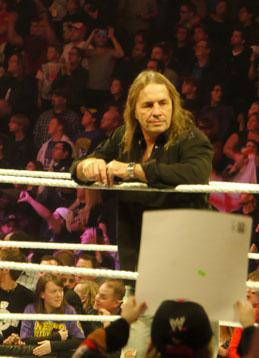
Bret barely wrestled in Canada after leaving WWF for WCW
“They should have gone into Canada, but they were doing such strong business in 1998 in the U.S. that they didn’t think about opening new markets,” explained Meltzer.
“They never saw Canada as much of a market. During their years on top they basically just ran Toronto and Vancouver,” added Greg Oliver of SLAM! Wrestling.
THE HITMAN’S RETURN
After some rough years in WCW, Hart suffered a stroke in 2002 while riding his bike. He almost died.
“Vince called me up when I had my stroke and we talked. Emotionally, for me, it was important for him to know I wasn’t bitter about what happened with [my brother] Owen [who died falling in an accident]. I felt somehow, through the family squabble, he didn’t really understand my position. It wasn’t this hatred I had for him and everything he stands for. It wasn’t about that at all. The truth is, I was so grateful for the opportunity to have the career I had and the chances he gave to me. When he called me and said we could still do that anthology. That was a really big turning point. That’s what I wanted,” Bret Hart revealed in Survival of the Hitman.
In 2005 the WWE proudly put up a picture of McMahon and Hart shaking hands, as Hart had just started working on his DVD anthology. In 2006 he was inducted into the WWE Hall of Fame, but refused to attend WrestleMania the following night.
This story was told all around the world, and obsessed wrestling fans haunted McMahon, Michaels and Hebner with the famous “You Screwed Bret” chant each time they had the chance.
And then, the unthinkable happened. On January 4, 2010, Bret Hart made his return to the WWE as a guest host on Monday Night Raw.
“It was time to forgive, see if I could turn a negative into a positive. If we could turn this whole thing and have a little fun with it,” Bret said in Survival of the Hitman.
Hart was the one who opened up talk for the return everyone wished for, but that no one believed would happen.
“In the end my decision was that I wanted to go out, let people see the old Hitman from 10 years ago come back. It felt strange, but I can tell you that when I did my little thing. It seemed that I was gone for about 10 minutes and not 12 years. I don’t think I ever did it with emotion like that in WCW,” he explained today in the same documentary.
On his Facebook page Hart said that his meeting with Shawn Michaels in the ring that night was the first real meeting since Montreal: “It’s worth mentioning that although I did see Shawn earlier in the afternoon in the cafeteria, our in-ring faceoff was unrehearsed and heartfelt on both sides, and I can finally say that Shawn and I have finally made peace in what has been a long, draining and sometimes pointless war of personalities.”
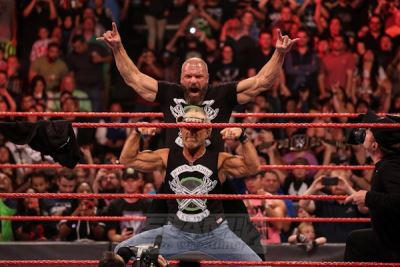
Shawn Michaels and his good friend Triple H, one of the few who knew about the screw job ahead of time
Michaels himself admitted after WrestleMania XXVI, as he was announcing his retirement, how important Hart’s forgiveness was to him.
“I’ve got to thank Bret Hart. I cannot tell you how much I drove that poor guy crazy. I want to thank him to have forgiven me. And I will forever honour his friendship,” said the wrestler who has been a Born-Again Christian for many years now.
WrestleMania XXVI would mirror for one last time the careers of the two men. Hart returned as a wrestler for the last time to fight Vince McMahon, and Michaels had his retirement match against The Undertaker.
The release of a three-DVD set about this feud is more than likely the last time the two men will discuss the matter in public. But Hart’s return to the Bell Centre on September 10, 2012, for Monday Night Raw, is probably the final chapter of the story.
“Since we sort of got back on good terms again, I always thought: ‘I wonder what will happen when they’re in Montreal … whenever that happens, it will be a Monday Night Raw eventually, they’ll have to think that maybe it would be a good idea to bring me into that,’ ” Hart told the Montreal Gazette. “I didn’t expect it in some ways and wondered if it would ever happen, and here it is.”
Hart received a hero’s welcome in a city that never forgets.
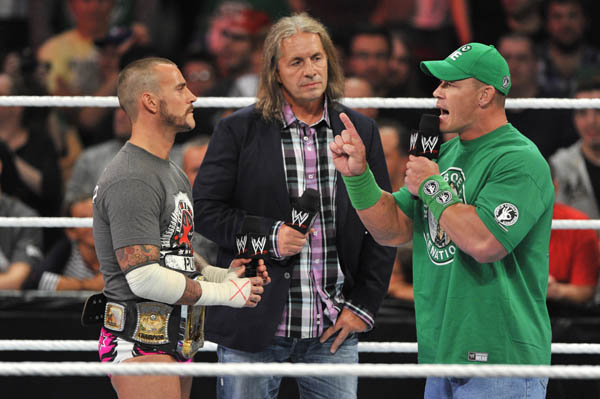
Bret Hart, with CM Punk and John Cena in the Bell Centre in Montreal in September 2012. Photo by Minas Panagiotakis
“I don’t think WWE thought it would get the reaction that it did. I think they thought it wouldn’t be a big deal. As you can see, I had a better feel for how that audience was going to react. But I’m grateful to WWE for doing it. It was really satisfying,” Hart told UK’s The Sun after the event, to put an end to the long saga of the Montreal Screw Job.
Ironically, he’s more popular in Montreal now than he was in 1997.
The week following the incident, Dave Meltzer wrote this in his newsletter: “It will go down in history as the single most famous finish of a pro wrestling match in the modern era. Twenty or 30 years from now this story, more than any famous wrestler jumping promotions, more than any prominent death, and more than any record setting house, will be remembered vividly by all who watched it live, and remembered as legendary from all who hear about it later.”
We are now 20 years later, and he couldn’t be more right.
(And for those out there who think it was all a work, just read this. Enough has been said already about that nonsense.)
— with the collaboration of Bertrand Hébert
RELATED LINKS
Pat Laprade was at the Molson Centre that night. He wasn’t smart to the business then, but he sure understood what it meant when Bret drew those W-C-W letters in the air. He still has a vivid memory of that. He’s also a commentator for WWE Raw on TVA Sports in Quebec since October of 2017. But his take on the matter hasn’t changed since. He can be reached at patric_laprade@videotron.ca, on his Facebook page and on Twitter.
